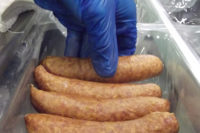Post-packaging pasteurization: Using heat to reduce risk

Post-packaging pasteurization has become an important intervention for reducing the Listeria monocytogenes hazard in packages of ready-to-eat (RTE) meat products, as well as extending the shelf life of RTE products.
This hazard is specific to RTE products that are post-lethality exposed to the environment (i.e., the casing is removed) before packaging, because of the potential for L. monocytogenescontamination to the exposed product during the packaging process. Because RTE products are not expected to be reheated before consumption, any L. monocytogenescontamination to the exposed products is likely to continue to grow in the package during refrigerated storage.
The Listeria Final Rule (430.1) applies only to RTE meat products that are post-lethality exposed before packaging. And this rule requires processors to comply with one of three alternatives.
Post-packaging pasteurization provides the post-lethality treatment that is required in Alternative 1 and is optional in Alternative 2. For the post-lethality treatment, a minimum of 1 log reduction in L. monocytogenes is required. In Alternative 2, post-packaging pasteurization allows processors to produce RTE meat products without the addition of antimicrobial ingredients. Establishments that use post-packaging pasteurization as a post-lethality treatment must have a critical control point (CCP) at this step in their HACCP plan and validate the effectiveness of this process.
A separate validation process would be required for products that vary in size, composition, etc. Some people prefer to call this process post-packaging reheating, rather than pasteurization, but the objective of eliminating surface contamination is the same.
L. monocytogenes is the major non-spore forming biological hazard associated with ready-to-eat (RTE) meat products. Most companies do not have a problem with eliminating L. monocytogenes from products during normal cooking processes. This hazard is more likely to occur when fully cooked products are exposed to the environment after cooking but during slicing and packaging, as a result of environmental contamination. This results in a surface contamination issue, since L. monocytogenes should be eliminated from the interior of the products during normal cooking. There are a variety of options for eliminating surface pathogens on packaged ready-to-eat meat products, such as water immersion, steam reheating, high-pressure processing (HPP), etc. This article will focus on the thermal applications, specifically.
Of the options available, hot water and steam for post-packaging pasteurization are most commonly used in the U.S. meat industry. Using water or steam for post-packaging pasteurization can be applied as either a continuous or a batch process. For companies that can’t afford the continuous systems that are available, existing ovens or water tanks can accomplish the same goal. A typical post-packaging pasteurization process might involve reheating the surface of larger packaged products for 10 minutes or less, at about 200 degrees, resulting in about a four log reduction of L. monocytogenes. The heating time would depend upon the temperature of the water or steam, the size of the product, configuration of the product in the package, the thickness of packaging film and the composition of the product. Smaller products would require less time to reach a lethality temperature on the product surface. The surface texture will also affect the heat treatment, as a rough product surface might require that the lethality temperature reach as deep as 15 millimeters below the surface.
Configuration of the product in the package will also impact the process. Obviously, a single sausage link is the easiest to uniformly apply a lethality treatment to the entire sausage surface. Multiple links in a package require a longer heat treatment, particularly to reach a lethality temperature where the links touch, resulting in more stress on the water-binding capacity of the product.
Packaged sliced products do not hold up well with hot water or steam processes, due to the loss of product moisture from the slices. High-moisture products may lose some moisture during this reheating process, and the migration of this moisture to the product surface will further increase the heating time and will accumulate between the packaging film and the product. If surface accumulation of moisture is enough to negatively affect the product appearance, either the product formulation or the processing methods may need to be adjusted to reduce the moisture cookout. The chilling rate after post-packaging pasteurization with heat must be considered, as it is calculated in a product’s total chilling time.
As consumers have become more demanding about the safety of the meat products that they eat and about seeing clean labels on product, post-packaging pasteurization has become a reliable method for producing safe, RTE meat products without the use of antimicrobial ingredients. Post-packaging pasteurization cannot only eliminate L. monocytogenes on the product surfaces, but can also extend the shelf life of RTE products to satisfy the retailers’ needs.
Lynn Knipe is the Extension Processed Meats Specialist and Associate Professor in Food Science and Technology, and Animal Sciences at Ohio State University. He is also a member of The National Provisioner Editorial Board. For more information, contact him at knipe.1@osu.edu or (614) 292-4877.
Looking for a reprint of this article?
From high-res PDFs to custom plaques, order your copy today!








